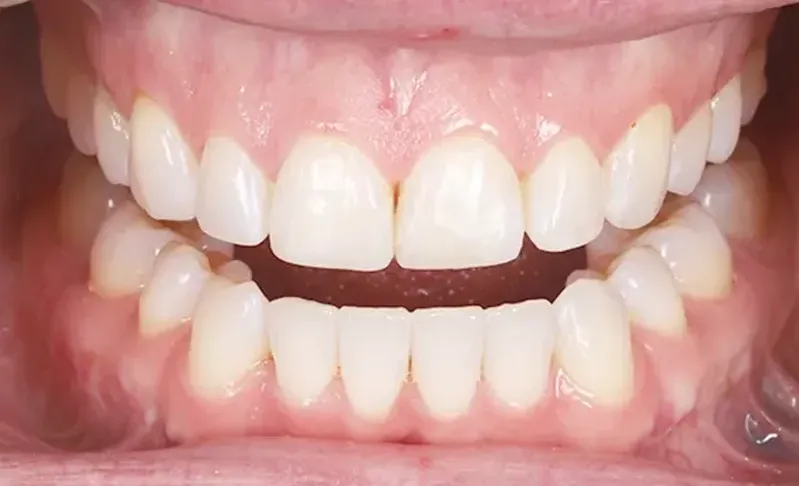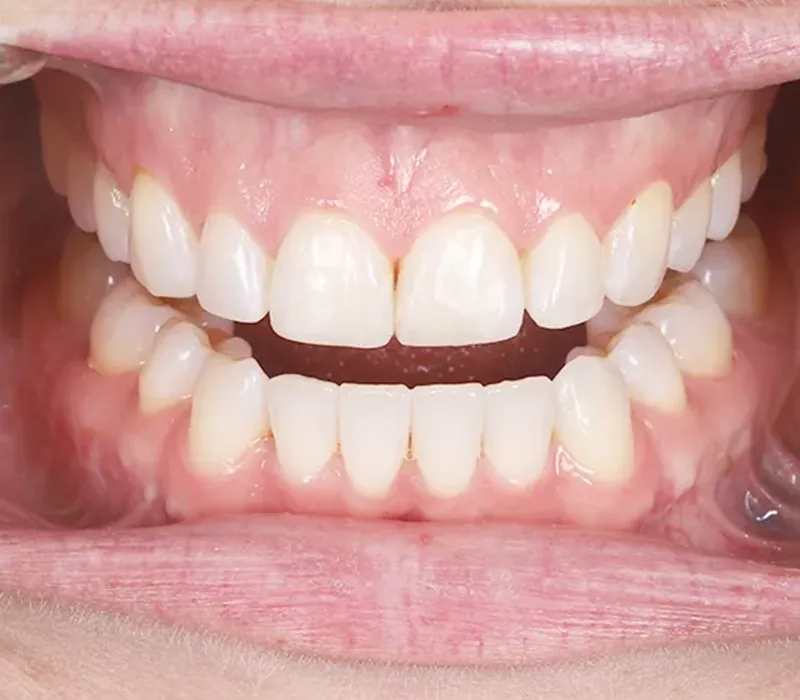A Case Study in Clinical Precision:
Minimally Invasive Composite Dentistry

This case study documents a conservative and aesthetic restoration of a compromised anterior dentition. The objective was to address functional and aesthetic deficiencies using precise, minimally invasive techniques.
Initial Clinical Presentation
A patient, referred to as Mrs S, presented to the clinic with concerns regarding the aesthetic quality of her smile. The clinical examination and photographic analysis revealed several key findings that required intervention:
- Existing Restorations: Teeth 11 and 21 (Upper Central Incisors) presented with old composite resin restorations. These showed evidence of marginal staining, wear, and discolouration, compromising the overall aesthetic and integrity of the bond.
- Anatomical Discrepancies: Tooth 22 (Left Lateral Incisor) was anatomically disproportionate to the contralateral tooth, creating a noticeable asymmetry in the smile line.
- Surface and Light Transmission: The incisal edges of the anterior teeth were misaligned, and there were significant variations in the translucency of the enamel, contributing to an uneven appearance.

Clinical Treatment Plan
The treatment strategy was developed to be as conservative as possible, preserving natural tooth structure while achieving a harmonious and durable aesthetic outcome. The plan included a staged approach:
1. Preparation and Whitening: The process began with a professional dental prophylaxis to remove plaque and calculus. This was followed by an in-chair Zoom whitening session to lighten the natural tooth shade, establishing a brighter, uniform foundation for the subsequent composite restorations.
2. Digital Smile Design (DSD): Prior to any restorative work, a DSD protocol was employed. This allowed for the virtual planning of the optimal tooth shape, size, and alignment. This digital workflow provided a precise blueprint for the final restorations, ensuring predictability and accurate outcomes.
- Teeth 11 & 21: The old, defective composite fillings were meticulously removed. A layered, nano-hybrid composite was then applied to rebuild the teeth. This multi-layer technique was crucial for mimicking the complex internal structure, subtle shades, and inherent translucency of natural enamel and dentin.
- Tooth 22: A direct composite veneer was fabricated to reshape and restore this tooth. The goal was to harmonise its size and contour with the opposing tooth to correct the smile asymmetry.

4. Finishing and Polishing: The final stage involved a multi-step polishing protocol. A series of fine discs and polishers were used to achieve a high-lustre, smooth surface. This finish is critical for light reflection, making the restorations indistinguishable from natural enamel, and for long-term resistance to staining.
Clinical Outcome
The treatment successfully addressed the initial clinical challenges and achieved the desired aesthetic and functional improvements:
- Improved Luminous Quality: The whitening procedure and the layered composite technique resulted in a visibly lighter and more luminous dentition.
- Seamless Integration: The new restorations on teeth 11 and 21 demonstrated seamless, undetectable margins where the composite blended into the natural tooth structure.
- Harmonised Smile Line: The reshaping of tooth 22 created a balanced and symmetrical smile line, correcting the initial anatomical imbalance.


This case effectively demonstrates the clinic’s use of advanced, conservative techniques in aesthetic dentistry. By prioritising the preservation of natural tooth structure and using a meticulous, layered approach to composite artistry, we were able to achieve a functional and highly aesthetic result.
Dr Su Lin Lim, Registered Dentist
DEN0001784834
